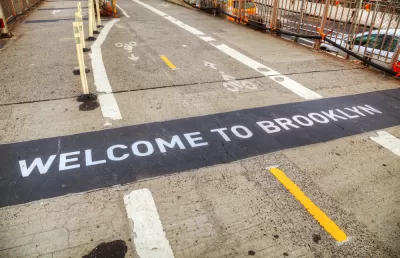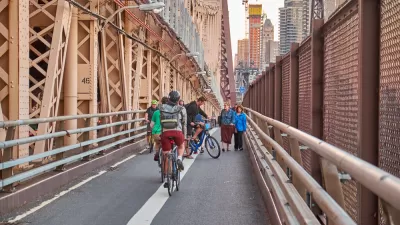Advocates want to see a safer plan for the proposed two-way path on one of the country's busiest commuter corridors.

The bike path proposed for the Brooklyn Bridge by New York Department of Transportation (NYDOT) engineers, writes Alissa Walker in Curbed, is "four feet wide in each direction, which is just barely enough for two pairs of handlebars abreast." And while "any dedicated bike path on the bridge that’s clawed back from traffic is a big improvement," Walker writes that the NYDOT's plan "is not nearly ambitious enough for a crossing on what’s arguably one of the most famous bridges in the world in a city with the largest bike-share system outside of China." NACTO's urban bikeway design guide recommends a 12-foot width for two-way cycleways, and the "convoluted meander of connecting paths at either side of the bridge" creates "a reliable recipe for collisions and crashes."
After adding 28 miles of bikeways in the city over the past year, the half-hearted Brooklyn Bridge design just doesn't "add up," writes Walker. "In an alternate timeline, the city would have widened the promenade so people on bikes got fresh air and skyline views instead of being condemned to the car cage below. But even with an imperfect path, the bridge is certain to get even more riders." Hopefully, Walker notes, the influx of commuters will convince the city to install a wider, safer bikeway in the future.
FULL STORY: The Brooklyn Bridge Finally Gets Its Own Bike Path! Except …

Alabama: Trump Terminates Settlements for Black Communities Harmed By Raw Sewage
Trump deemed the landmark civil rights agreement “illegal DEI and environmental justice policy.”

Planetizen Federal Action Tracker
A weekly monitor of how Trump’s orders and actions are impacting planners and planning in America.

The 120 Year Old Tiny Home Villages That Sheltered San Francisco’s Earthquake Refugees
More than a century ago, San Francisco mobilized to house thousands of residents displaced by the 1906 earthquake. Could their strategy offer a model for the present?

In Both Crashes and Crime, Public Transportation is Far Safer than Driving
Contrary to popular assumptions, public transportation has far lower crash and crime rates than automobile travel. For safer communities, improve and encourage transit travel.

Report: Zoning Reforms Should Complement Nashville’s Ambitious Transit Plan
Without reform, restrictive zoning codes will limit the impact of the city’s planned transit expansion and could exclude some of the residents who depend on transit the most.

Judge Orders Release of Frozen IRA, IIJA Funding
The decision is a victory for environmental groups who charged that freezing funds for critical infrastructure and disaster response programs caused “real and irreparable harm” to communities.
Urban Design for Planners 1: Software Tools
This six-course series explores essential urban design concepts using open source software and equips planners with the tools they need to participate fully in the urban design process.
Planning for Universal Design
Learn the tools for implementing Universal Design in planning regulations.
Clanton & Associates, Inc.
Jessamine County Fiscal Court
Institute for Housing and Urban Development Studies (IHS)
City of Grandview
Harvard GSD Executive Education
Toledo-Lucas County Plan Commissions
Salt Lake City
NYU Wagner Graduate School of Public Service





























